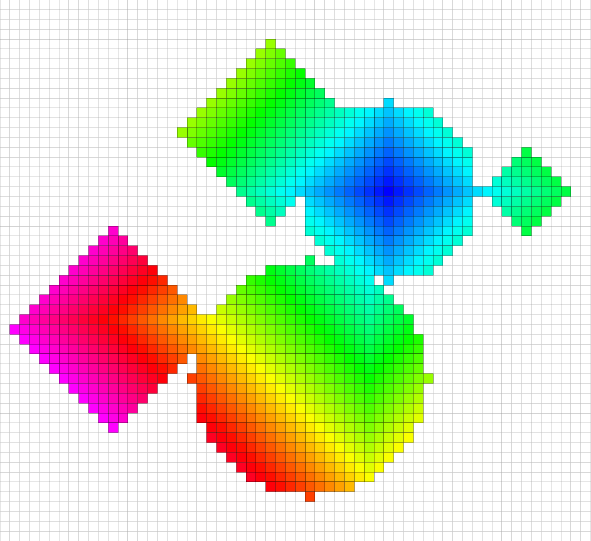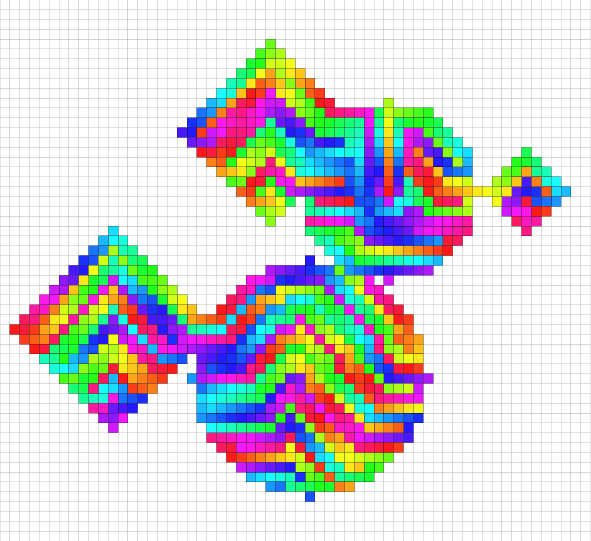Table of Contents
- Author(s) of this documentation:
- by Jacques-Olivier Lachaud
Part of the Graph package.
This module defines what are graphs in DGtal, as well as basic associated concepts. Relevant digital models of graph are notably found in Topology package.
The following programs are related to this documentation: graph/graphTraversal.cpp, graph/volDistanceTraversal.cpp
Graph concepts in DGtal
There are many different ways for representing a given graph, even without considering types that attached data to vertices and edges, the most notable ones are adjacency lists per vertex, incidence matrix, outgoing edges per vertex. A rather comprehensive set of finite graph concepts may for instance be found in the boost::graph module.
Graphs in DGtal may be finite (like Object) or only locally finite (like MetricAdjacency). Graphs in DGtal are undirected. Therefore, they are two different concepts for graphs:
- locally finite graphs satisfy concept concepts::CUndirectedSimpleLocalGraph. There is no way to iterate through all vertices of that kind of graph (since they can be infinite). Edges of this graph are given through an adjacency list for each vertex.
- Notable models: MetricAdjacency
- Notable refinements: concepts::CAdjacency, concepts::CUndirectedSimpleGraph
- finite graphs satisfy concept concepts::CUndirectedSimpleGraph, a refinement of concepts::CUndirectedSimpleLocalGraph. Such graphs provide vertex iterators to enumerate all the vertices of the graph. Such iterators may only be single pass input iterators.
- Notable models: Object, DigitalSurface, LightImplicitDigitalSurface, LightExplicitDigitalSurface, TriangulatedSurface
All graphs define a Vertex (which must be instance-able, copy-able, assignable) and a Size type (type for counting vertices). Furthermore, they must provide a default type VertexSet for representing a set of Vertex, and a defaut type rebinder VertexMap for representing a map with key Vertex.
- Note
- DGtal graph concepts are very light compared to boost::graph for instance. The advantage is that it is easy to create new models of graph in DGtal. The disadvantage is that you may not be able to design the best optimized graph algorithms in some case.
- Note
- For now, DGtal does not provide a generic graph model.
Using graphs
This section gathers the basic ways of using graphs.
Instanciating graphs
The instantiation of graphs (like any object) is dependent on the chosen graph model. For instance, to instantiate a MetricAdjacency or an Object, you can consult Digital topology and digital objects. To instantiate a DigitalSurface, you may consult High-level classes for digital surfaces.
Here is a simple example for creating a 2D digital object seen with the (4,8) adjacency (in example graph/graphTraversal.cpp)
The last line above checks that Object are finite graphs.
Enumerating vertices of a graph
We simply use the range [begin(),end()) offered by graphs. This is done as follows.

Enumerating edges of a graph
You may obtain edges of a graph by using method writeNeighbors as follows:
Graph traversal with visitors
Sometimes it is more convenient to traverse in a specific order, and not in the arbitrary order given by vertex enumeration. That is exactly the purpose of visitors, specified by concept concepts::CGraphVisitor. Visitors traverse the graph or only subparts of the graph by adjacencies. In some sense, they trace a tree from the initial seed. A vertex is visited at most once. Data may be associated to each visited vertex, like its distance to the initial seed. Three models of visitors are provided, two of them implement the classical breadth-first and depth-first traversal:
- model BreadthFirstVisitor performs the traversal of a connected graph by breadth-first search. If the graph is not connected, only the connected component(s) containing the initial seed(s) are visited. This visitor also computes the distance to the initial seed(s), which is also the topological distance to the seed(s) (see graph/graphTraversal.cpp).
- model DepthFirstVisitor performs the traversal of a connected graph by depth-first search. If the graph is not connected, only the connected component(s) containing the initial seed(s) are visited. This visitor also computes the distance to the initial seed(s) as the number of ancestors in the depth search (see graph/graphTraversal.cpp).
- model DistanceBreadthFirstVisitor performs the traversal of a connected graph by a modified breadth-first search: it is based on a priority queue, the priority of which is given by a distance object (and not by the topological distance as in classical breadth-first traversal). If the graph is not connected, only the connected component(s) containing the initial seed(s) are visited. This visitor also gives the distance given by the distance object (see graph/volDistanceTraversal.cpp).
The snippet below shows how to use a visitor to color vertices according to the topological distance to the initial seed (the point (-2,-1)). The node is a std::pair<Vertex,Data>, where Data is the distance.

- Note
- The traversal of the graph can be changed dynamically in two ways:
- visited vertices can be limited with a model of concepts::CVertexPredicate (e.g. see BreadthFirstVisitor::expand( const VertexPredicate & ) ).
- you may forbid some visited vertices to have descendants (e.g. see BreadthFirstVisitor::ignore() ).
Transforming a visitor into a range
It is sometimes convenient to transform a visitor into the usual range / iterator pair. For instance, it is used by light containers for digital surfaces to iterate through all vertices on-the-fly (see LightImplicitDigitalSurface, LightExplicitDigitalSurface). This is done easily with class GraphVisitorRange. This class transforms an arbitary model of concepts::CGraphVisitor into a single pass input range (on Vertex or on Node).
The following snippet transforms a DepthFirstVisitor into a range.
